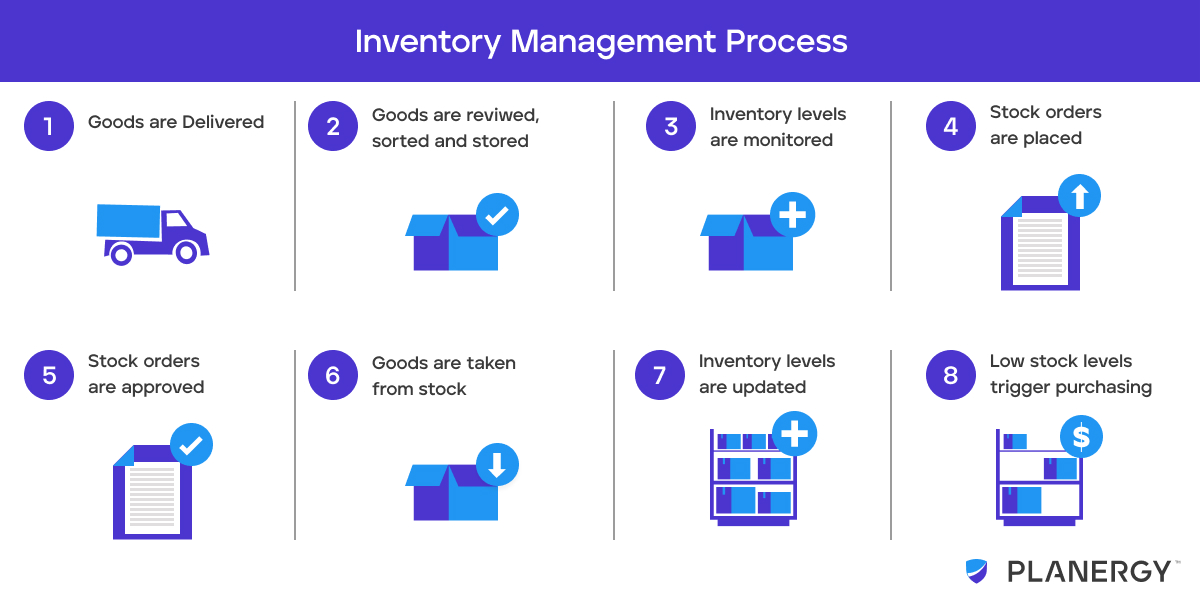Working in procurement means tackling responsibilities that cover a lot of different, but interrelated, tasks. One of the most important, and often most complicated, of these tasks is supply chain management—and within it, the inventory management process (IMP).
The methods you choose when recording, tracking, and managing your inventory have a huge impact on a wide array of critical business processes.
From production essentials like raw materials to indirect but important items such as office supplies and marketing materials, all the items in your physical inventory have a chance to enhance or deplete your bottom line, depending on how they’re managed.
It follows, then, that effective inventory management is essential to a healthy and competitively successful business.
Fortunately, by working to develop a thorough understanding of the inventory management process, applying the right inventory management techniques, and investing in useful tools such as inventory management software, you can optimize your inventory processes for optimal efficiency, productivity, and profitability.
Understanding the Inventory Management Process
Any business that relies on physical inventory items of any kind (which is to say, most businesses) needs a reliable method for recording, analyzing, and managing their stock of those items.
Creating and implementing an effective inventory management process—sometimes also referred to as inventory process management, or IPM—makes it possible to accomplish these goals with maximum workflow efficiency/efficacy, optimal return on investment (ROI) and minimum expense.
Optimizing inventory management is a very important part of cost control, and can have a powerful impact on supply chain management by affecting cash flow, vendor management/strategic sourcing, and relationships with vendors and customers alike.
Core inventory management techniques include:
- Inventory Control, which is a general term for reducing total inventory management costs while optimizing the company’s ability to meet customer demand and its own goals for profitability and competitive strength. Many businesses around the world use this term interchangeably with inventory management.
- Stock Review, which compares available stock levels to future estimated needs. Traditionally, stock review is physical and manual, making it prone to human error as well as both time-consuming and labor-intensive. However, automation technology is rapidly changing this standard by allowing inventory managers to set minimum inventory levels and automatically reorder goods as needed.
- Cycle Counting, during which specific portions of inventory are counted (usually with a physical inventory count) based on a repeating schedule. Cycle counting is also known as cycle inventory and ensures every item is counted at least once in a given accounting period (usually a year).
- ABC Analysis, a comparative analysis methodology that classifies inventory into A, B, and C groups based on value and quantity.
- “A” Goods are low in available quantity but high in value.
- “B” Goods are of both moderate value and availability.
- “C” Goods are low in value but high in available quantity.
This approach allows for precise and detailed analysis of usage, and makes it easier to maintain buffer stock without wasting time and money with needless inventory bloat.
For example, goods from category “A” are more expensive, but sell more slowly than “B” or “C” goods, and so require much smaller inventories.
As with Stock Review, performing ABC analysis with outdated tech tools can make the process time-consuming and labor-intensive, although modern inventory management software with advanced machine learning and data analysis tools have the power and versatility to speed things along.
- Just-in-Time (JIT), an inventory system that relies on analytics and precision logistics to ensure materials and goods arrive on demand for immediate turnaround to customers. JIT is very data-intense, and requires a clear and complete understanding of factors such as seasonal demand, geographic and political events that might affect logistics, and customer buying patterns, both in the short and long term. Done properly, Just-in-Time simplifies inventory by minimizing the need for available goods and raw materials and reducing lead times. However, it is susceptible to failure without complete information and the data analysis tools required to manage it.
- FIFO and LIFO, which refer to either first-in, first out (FIFO) or last-in, first-out (LIFO) valuation methods. FIFO and LIFO are the accounting components of inventory management systems, detailing the actual value of inventory to your company’s bottom line.

The methods you choose to track inventory will vary by industry and the size of your business, but in general, the inventory management process itself will look something like this from a procurement perspective:
- Goods are delivered to the receiving area of the warehouse. These can include:
- Raw materials and components (for manufacturers)
- Finished goods for resale (for distributors)
- Indirect materials that support the daily operations of a business but not production (businesses of all kinds)
- Goods are reviewed, sorted, and stored on shelves in special stock areas. Small businesses may not have a separate receiving department, and the warehouse will serve double duty as a stocking area. Goods may be assigned stockkeeping unit (SKU) codes and tagged with barcodes for easier tracking.
- Inventory levels are monitored regularly, with physical inventory counts performed periodically in addition to whatever automated inventory management measures are in place. This ensures everyone has an accurate understanding of available inventory and helps minimize the chance of stockouts, dead stock, missed or duplicated orders, and risk exposure due to theft and fraud.
- Orders are placed by customers, either internal or external. For example, a consumer may place a purchase order for the company’s products, the sales department may submit a sales order, or a staff member may submit a requisition for office supplies.
- The order approval is verified against original purchase order, sales slip, internal purchase requisition, etc.
- The required goods are pulled from stock areas and sent either to production (manufacturing), directly to the retailer/customer/end user (finished goods), or routed to the appropriate business unit/department (internal requests).
- Records are updated and shared with all relevant stakeholders.
- Inventory levels are used to restock goods and materials as needed. For Just-in-Time systems, usage data may be analyzed to create more accurate forecasts.
The growing availability of advanced tech tools such as deep data analytics and process automation—both supported by general artificial intelligence and more particularly by iterative improvements through machine learning—has made it possible for companies ranging from small businesses to global conglomerates to develop, implement and streamline inventory control.
Optimizing inventory management is a very important part of cost control, and can have a powerful impact on supply chain management by affecting cash flow, vendor management/strategic sourcing, and relationships with vendors and customers alike.
Benefits of an Efficient Inventory Management System
To implement an IMP effectively, you need an inventory management system, or IMS. This is simply a formalized set of processes, designed to help your team achieve optimal performance in key areas including:
- Order management.
- Inventory control (IMP).
- Multichannel sales (depending on your industry and customer base).
- Centralized and comprehensive reporting and data analysis.
- Inventory forecasting.
- Purchase order creation and management.
- Warehouse management and synchronization.
Done properly, every step of the inventory management process is ripe with potential for value.
Consider these benefits:
Improved Process and Staff Efficiency
With an inventory management system in place, your team will spend less time on low-value, tedious, and time-consuming inventory tasks and more time using their skills to innovate and build value.
This is especially true with help from process automation, which eliminates the need for human intervention while simultaneously removing human error.
Less Waste and Lower Costs
When you have absolutely accurate inventory information available in real time, you can optimize inventory levels more effectively.
This reduces inventory holding costs, inventory write-offs, and helps reduce the chances you’ll overbuy, too.
Bloated inventory levels can cost your company a pretty penny over time, especially if you’re dedicated storage space, time, and expense to items with low demand.
On the other side of the coin, that same accuracy of inventory data will insulate you against overselling as well.
You’ll be able to meet demand as it comes and maintain a positive reputation with customers and vendors.
More Effective Long-Term Inventory Planning
Whether you’re a manufacturer, a distributor, or a service-based business managing indirect inventory needs, having a transparent and comprehensive view of your inventory levels will make it much easier to refine your overall inventory management, as well as production, sales, and supply chain planning.
Potential Inventory Management Challenges
Naturally, even the most well-optimized inventory management system is still one created by humans, and therefore susceptible to potential problems.
Keep in mind these common inventory management headaches when developing your own system:
The IMP Can Be Complex
There’s a lot of moving parts involved with inventory management, and while formalizing your approach to each component will go a long way toward minimizing miscommunication, risk, and errors, it’s a serious gamble to dismiss the need for your whole organization to commit to not just understanding, but using, your new IMP.
You’ll likely need a generous lead-up period to help everyone get accustomed to both the new policies and whatever tools you’re adding to their workflows.
Doing so is much simpler if you combine inventory management techniques with modern inventory management software, but even so, it’s a good idea not to underestimate the time and training your team, vendors, and customers may need to get on board with your new and improved inventory process.
Risk Remains a Factor
Formalized processes and automated workflows are powerful tools for reducing risk due to errors and inefficiencies.
But keeping risk at bay means monitoring your inventory management process with an eye for both iterative improvement and potential errors—particularly if you’re working with inventory management software that doesn’t have advanced data analytics or process automation supported by self-learning artificial intelligence.
In addition, it’s critical to connect your IMP to your quality control and supply chain management solutions.
This integration will provide you with the additional context necessary to guard against production or sourcing missteps that can negatively affect your reputation and bottom line.
Implementing Inventory Management Software Can Be Resource-Intensive
In addition to the potential investment, your company may require significant time and effort to achieve buy-in from the C-suite and the company as a whole.
If you’re implementing inventory management as part of a larger procurement solution or making the move from manual processes to automated ones, you may need to invest in additional training and education before you can “go live.”
Developing a Winning Inventory Management Process
No two companies have exactly the same inventory management needs, but every business can benefit from a few best practices when building their inventory management process.
- Know your budget. Choosing an IMP solution that connects with procurement, enterprise resource planning (ERP), and accounting software will let you connect the financial dots and make best use of FIFO/LIFO as best fits your financial goals.
- Store and Ship Smart. The type, scale, and number of warehouse facilities you need will depend heavily on your industry and company size. A frozen foods distributor will have very different requirements than a steel manufacturer, for example. In addition, if you’ll likely require multiple storage locations, choosing a comprehensive inventory management solution can make it much easier to coordinate shipping and warehouse management by creating a centralized, shared database.
- Choose Inventory Management Software That Fits Your Needs. There’s certainly no lack of options when shopping for inventory management solutions. But in inventory, as in life, not all paths lead to the summit of success. That’s why it’s important to find and implement inventory management software that meets your needs without introducing needless expense or complexity to an already complicated process.For example, a cloud-based, comprehensive procurement solution such as Planergy not only provides a robust inventory management module, but the artificial intelligence, data analysis tools, and process automation capabilities you need to integrate inventory management into your entire software environment. In choosing an inventory management system, be sure to look for:
- Process automation, supported by artificial intelligence. (Smarter automation makes it much easier to free your team from menial tasks while improving accuracy and reducing costs, waste, and delays.)
- Full data transparency for more accurate and complete data analytics, better decision making and invoice forecasting, and more valuable strategic insights.
- Full integration with your existing software environment, including sales, marketing, accounting, and the entire procure-to-pay (P2P) process, as well as supply chain and supplier relationship management.
- A proven track record of longevity and performance.
- Confirmed success with, and endorsements from, clients of various sizes from your company’s industry.
- Training and educational tools to help achieve any cultural changes needed to support the procedural changes in your IMP.
Better Inventory Management is Possible
Some days, it might seem that managing the goods you use to create your own products is a bigger obstacle to overcome than actually selling them to your customers.
But while inventory management can be challenging, it doesn’t have to be frustrating.
Investing in the right inventory management software and using it to execute a well-developed inventory management process is a surefire way to ensure you have the inventory you need, when you need it, while cutting wastes, expense, and inefficiency out of your workflows.




